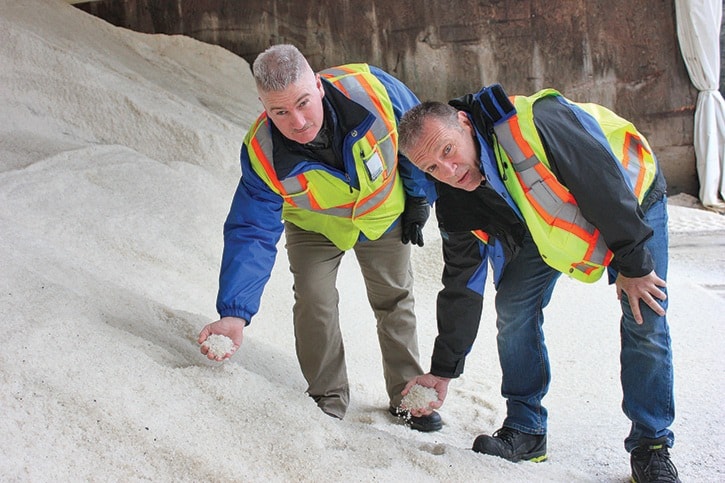When snow and ice are in the forecast, Nanaimo’s public works department takes action to ensure thousands of kilometres of pavement are safe for motorists.
Assisting the City of Nanaimo in its fight to keep roads clear is a small white ionic compound known as sodium chloride – or road salt.
Gary Davenport, the city’s roads foreman, said with more than 1,100 lane kilometres to maintain, Nanaimo has plenty of sodium chloride on hand.
“Typically we have somewhere in the neighbourhood of 400 to 500 metric tonnes that we stock up for,” he said.
David Myles, manager of roads and traffic, said this season crews have had to use around 800 tonnes of road salt, compared to last year when only 100 tonnes were used.
He said the city also uses sand and brine, a mixture of water and sodium chloride that is often applied when heavy snow is expected.
“If the weather is dry, we will start brining the roads,” Myles said. “What that does is, when it starts to snow, the snow will not bond to the road. It buys us time so that when we hit the road with the plows, the snow will come right off.”
While the temperature outside may be above freezing, the pavement temperature can be much colder, according to Myles. He said sodium chloride becomes ineffective when temperature are well below freezing.
“Salt is good until –6 C or –7 C,” he said. “After that we would put sand down and that’s just for traction.”
Although sodium chloride is cheap and effective, it can have a negative impact on water quality, roadside vegetation and the environment.
Davenport said crews are aware that sodium chloride can be harmful to vegetation and that his crews tend to apply around 60 to 80 kilograms of salt or brine per lane kilometre.
“You don’t want to go out and salt the same street 35 times and have that much salt on the road,” he said. “Typically we try to put down somewhere between 60 to 85 kilograms per lane kilometre as far as weight goes. That’s kind of the safe zone.”
In 1994, the ground water in the Heffley Creek, a community near Kamloops, became contaminated after a spill of road salt occurred at a storage facility near a well. As a result, the province was forced to find an alternate drinking source for the community and by 1999 the incident cost taxpayers $2 million, according to a report by the B.C. Auditor General.
Myles isn’t aware of any instances where the use of road salt has resulted in significant environmental damage or impacted drinking water in Nanaimo. He said the city typically receives its salt from Chile and follows the federal government’s environmental management of road salts guidelines.
Other communities such as Niagara-on-the-Lake, Ont., and Williams Lake have tried mixing beet juice with sodium chloride.
A report by the Niagara Region states that using beet juice will save the region “$2 per lane kilometre” and cut its sodium chloride use by roughly 30 per cent.
“Unfortunately, beet juice doesn’t work out here on the coast because we have such high humidity,” Myles said.
For now, the city will rely on sodium chloride and the men and women who are tasked with maintaining Nanaimo’s roads each day and night.
“We have staff out 24/7. We have a night patrol from 4 p.m. until midnight and then another guy out from midnight until 8 a.m.,” Myles said. “During the winter months, we have two guys that start specifically at 5 a.m. for snow and ice. They’re out there patrolling our known areas. One guy is in the north and one guy is in the south.”
reporter2@nanaimobulletin.com
